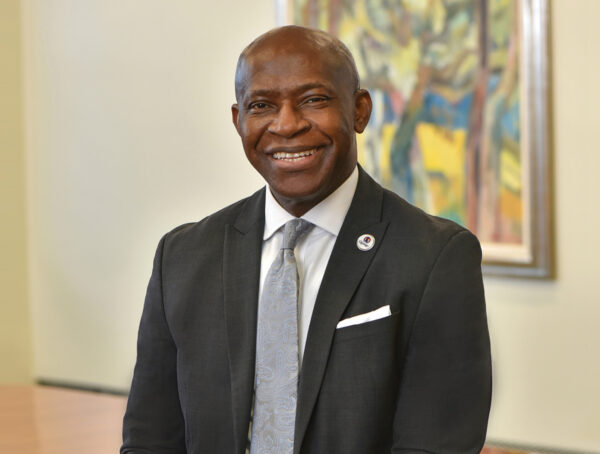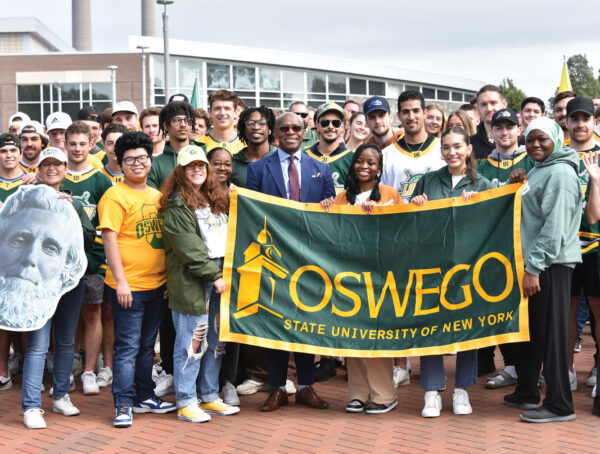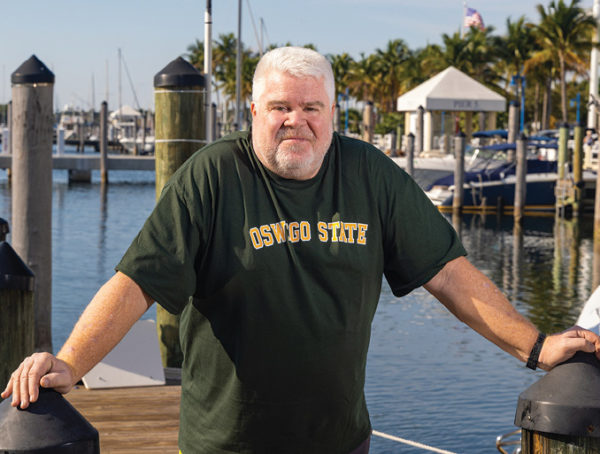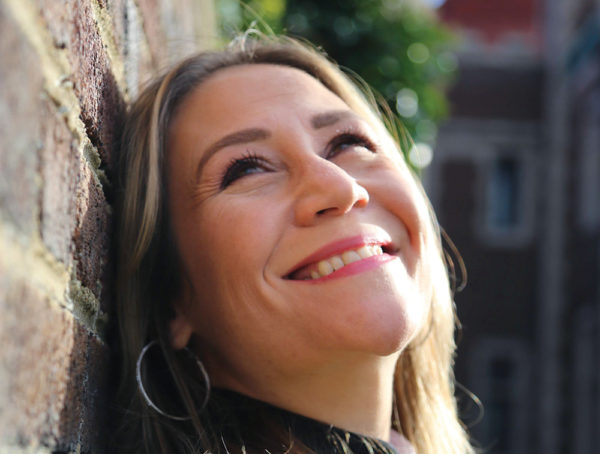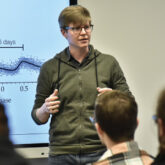VISION 4040: Expanding SUNY Oswego’s Promise

Bold plan seeks to double the annual number of graduates by 2040 to meet the needs of the CNY region
Even before Peter Nwosu officially started Aug. 15 as the 11th president of SUNY Oswego, he began meeting with current university leadership and formulating a vision for his presidency. Director of Institutional Research and Assessment Deborah Furlong remembers her first exchanges with Nwosu from mid-July 2023.
In their first phone call, he asked her to explore trends that would move Oswego from graduating 2,000 students a year to 4,000 a year, or double the number of graduates.
Furlong mapped out how that growth might happen over the next 20 years or so, and sent him a graph of the growth that would be required to achieve the goal.
“It was during the time I was doing the math behind the graph that I wrote into my work journal ‘This is insane, but that’s just me,’” recalled Furlong, who was well-versed on higher education’s enrollment challenges due to fewer high school graduates and changing demographics, especially in the northeast.
“The one thing I learned while working on the president’s vision statement is that the global middle class is an untapped reservoir for those institutions (and countries) that can build the strongest pipelines the soonest,” she said. “I do think Oswego has the potential and ability to be this kind of strong conduit between the international economy and what has the potential to be a Micron-led economic boom here in Central New York. But, yes, I initially thought the idea was insane and I eventually showed [the president] where I wrote that note in my journal, knowing he would find it amusing.”
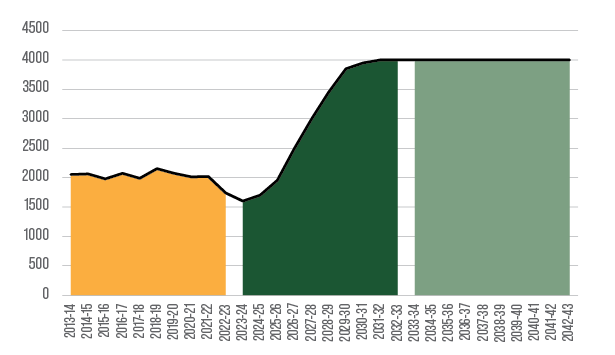 Nwosu did indeed find her journal entry amusing and has referenced Furlong’s comment multiple times in public settings before introducing Vision 4040, which establishes a pathway for SUNY Oswego to stabilize degree attainment of 4,000 awards per year — or 40,000 per decade — by the year 2040.
Nwosu did indeed find her journal entry amusing and has referenced Furlong’s comment multiple times in public settings before introducing Vision 4040, which establishes a pathway for SUNY Oswego to stabilize degree attainment of 4,000 awards per year — or 40,000 per decade — by the year 2040.
Unveiled at the inaugural State of the University Address, Vision 4040: Expanding SUNY Oswego’s Promise illustrates in broad brushstrokes how this goal to double the number of graduates can be achieved and why it is important for the region.
“What I envision for SUNY Oswego builds on the promise of access and opportunity; of meeting students where they are and helping them map out career paths; of sharing our resources with external partners and stakeholders for mutually beneficial outcomes; of driving the economy of the region by educating a skilled workforce; and of maintaining and sustaining our democratic society,” President Nwosu said.
He explained that the plan was needed to be ready to respond to meet the needs of the region. For example, he described how the percentage of Oswego County residents with bachelor’s degrees lags behind CNY and the state, so the university has an opportunity to increase the number of local residents it educates.
Additionally, with the expected $20 billion investment of Micron Technology over the next 10 years and the expansion of our current employers in the region, the five-county Central New York region’s population is predicted to grow by 5 to 10 percent, with some areas growing as much as 25 percent, in the next 20 years.
“During my first one-on-one meeting with President Nwosu when he started, he asked me about Micron and the region because I am an economist,” said Faculty Assembly Chair and Professor of Economics Elizabeth Schmitt. “I said, ‘This is my adoptive home as of 1995, and this is the single best piece of economic news that this region has received since I have been here. This brings people back to Upstate New York, and people are going to want to do all sorts of things. It’s not only tech people or programs that will benefit. This is a rising tide that lifts all boats.’”
The area’s relative climatic stability and access to fresh water are attractive to global manufacturers and employers, so other companies are likely to move into Central New York as well.
Vision 4040 also outlines an opportunity to tap into the burgeoning global middle class, which is expected to increase by 175 million people annually over the next decade, by recruiting more international students.
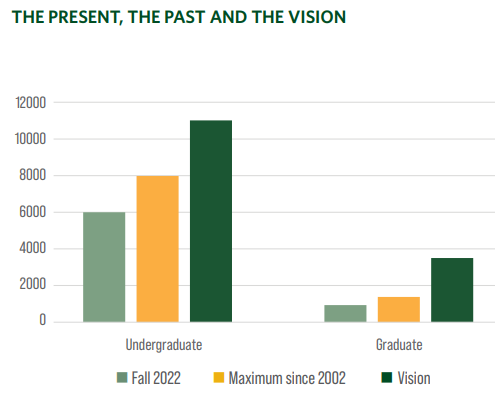 SUNY Oswego’s Vision 4040 preliminarily calls for an undergraduate enrollment of 11,000 students and 3,500 graduate students. These figures include residential, commuter and online students as well as part-time and full-time students, graduate students, certificates and microcredentials, and those who study at the Syracuse Campus and main campus.
SUNY Oswego’s Vision 4040 preliminarily calls for an undergraduate enrollment of 11,000 students and 3,500 graduate students. These figures include residential, commuter and online students as well as part-time and full-time students, graduate students, certificates and microcredentials, and those who study at the Syracuse Campus and main campus.
The university will also focus on developing and marketing micro-credentials and certificate programs to deliver smaller sets of high-demand skills and to serve as a low-risk on-ramp into full degree programs. The Vision 4040 process will also explore the university’s ability to develop scaffolded programs — stackable credentials — in areas not typically included in a four-year institution’s portfolio.
The plan seeks to increase the percentage of adults in Central New York with a bachelor’s degree from 12 percent to the state-wide average of 18 percent through targeted marketing of offerings, providing flexible course structures and modalities, offering in-demand academic programs, showing career possibilities and communicating the power of education to transform lives.
Vision 4040 also suggests that SUNY Oswego recruits more students from overseas, particularly in countries that have ties to Central New York corporations and businesses.
“The pool of students in New York State that we traditionally draw from has been shrinking for decades, and then COVID happened,” said James McMahon, SUNY Oswego College Council chair. “Education is changing, and I’m pleased with what he’s doing to keep Oswego moving forward.”
Vision 4040 explores what changes are anticipated to unfold with the arrival of the Micron Technology chip plant into Clay, N.Y., and the company’s expected investment of $20 billion in the region over the next 10 years and up to $100 billion over the next 20 years, according to a October 2022 White House announcement on the landmark economic development project. This also includes the direct expected employment of 9,000 people and the creation of an additional 40,000 jobs indirectly.
The university’s plan considers what new degree programs and credentials might be needed in Central New York’s future, and how SUNY Oswego can evolve to meet these needs.
Nwosu stressed the benefits of higher education for students as well as for the region.
“Communities with higher educational attainment have less crime, reduced expenditures on public assistance programs, higher participation in civic and volunteer activities, more homeowners and more people with high-quality health insurance coverage,” he said.
“All of this speaks to the vital role that education plays in our democratic society,” Nwosu said. “We do more than teach students. We empower them to change their lives and their families’ lives. Through education, we strengthen communities.”
For more information, visit oswego.edu/vision4040.
You might also like
More from Featured Content
A Vision of Support
A VISION of Support Award-winning principal makes an impact on her school through her positivity and commitment When Nicole Knapp Ey ’02 …
Changing Climate
Coral reef scientist seeks to protect and restore marine ecosystems Perhaps it was the 100 inches of snow that fell in …







